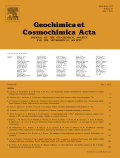
GEOCHIMICA ET COSMOCHIMICA ACTA
Scope & Guideline
Fostering Knowledge in the Heart of Earth Sciences
Introduction
Aims and Scopes
- Geochemical Processes and Cycles:
The journal emphasizes the study of various geochemical processes, including the cycling of elements, isotopic fractionation, and the interactions between minerals and fluids in diverse geological settings. - Planetary Geochemistry:
Research on the geochemical composition and processes of planetary bodies, including the Moon, Mars, and asteroids, is a core focus, contributing to our understanding of the solar system's evolution. - Environmental Geochemistry:
Contributions that explore the impact of anthropogenic activities on geochemical processes, such as pollution and climate change, are also significant, reflecting the journal's commitment to addressing contemporary environmental issues. - Experimental and Theoretical Studies:
The journal publishes both experimental and theoretical studies that provide insights into geochemical reactions, mineral stability, and the thermodynamic properties of geological materials. - Isotope Geochemistry:
There is a strong emphasis on isotopic studies, which are used to trace processes such as fluid movement, biogeochemical cycling, and the origins of geological materials.
Trending and Emerging
- Biogeochemistry and Microbial Processes:
There is a growing interest in the interplay between geochemistry and biology, particularly how microbial processes influence geochemical cycles and the formation of minerals, reflecting a broader trend towards integrating biological and geochemical research. - Climate Change and Environmental Impact Studies:
Research addressing the impacts of climate change on geochemical processes, including the cycling of trace elements and nutrients in aquatic and terrestrial systems, has seen a marked increase, driven by the urgent need to understand anthropogenic effects on the environment. - Advanced Isotope Techniques:
Innovations in analytical techniques for isotopic studies, such as clumped isotope thermometry and high-precision mass spectrometry, are on the rise, reflecting advancements in technology that allow for more detailed and nuanced investigations of geochemical processes. - Planetary Exploration and Sample Return Missions:
Research related to planetary exploration, particularly studies emerging from sample return missions (e.g., Mars, asteroids), is increasingly prominent, as these studies provide valuable insights into the composition and history of other celestial bodies. - Interactions between Water and Rocks:
Emerging studies focusing on the interactions between aqueous fluids and geological materials, particularly in the context of mineral dissolution and alteration processes, are gaining traction, highlighting their significance in understanding both terrestrial and extraterrestrial geochemical processes.
Declining or Waning
- Traditional Mineralogy:
While mineralogy remains relevant, the focus on purely descriptive studies of mineral properties and occurrences has diminished as the field moves towards integrating mineral studies with geochemical processes and environmental impacts. - Geochemical Analyses with Limited Contextualization:
Papers that present geochemical analyses without sufficient contextualization within broader geological or environmental frameworks are becoming less frequent, as the journal increasingly values studies that link geochemistry to larger geological narratives. - Static Geochemical Models:
The use of static models to describe geochemical processes is declining, as researchers favor dynamic models that account for temporal changes and the complexity of geological systems. - Local Studies with Limited Global Significance:
Research that focuses solely on localized geological phenomena without implications for broader geochemical cycles or planetary processes is less frequently published, reflecting a trend towards studies with wider applicability.
Similar Journals
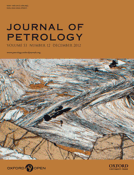
JOURNAL OF PETROLOGY
Illuminating the Foundations of Geophysics and MineralogyJOURNAL OF PETROLOGY is a prestigious academic journal published by Oxford University Press, dedicated to the fields of geochemistry, petrology, and geophysics. Established in 1960, it has garnered significant recognition within the scientific community, currently holding an impressive Q1 ranking in both Geochemistry and Petrology as well as Geophysics, as of 2023. The journal is indexed in Scopus, ranking 20th out of 165 in Geophysics and 31st out of 154 in Geochemistry and Petrology, reflecting its high impact and contribution to Earth and Planetary Sciences. Designed for researchers, professionals, and students, the journal publishes cutting-edge research and reviews that advance our understanding of igneous and metamorphic processes, mineralogy, and the Earth's structure. With a commitment to rigor and scientific excellence, JOURNAL OF PETROLOGY serves as a vital resource for developing new concepts and methodologies in the study of Earth’s materials and processes.
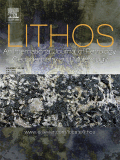
LITHOS
Advancing the Frontiers of Earth Science.LITHOS is a prestigious academic journal published by Elsevier, renowned for its contributions to the fields of Geochemistry and Petrology. As an integral platform since 1968, this journal focuses on advancing the understanding of the Earth's composition and processes, adhering to the highest academic standards as evidenced by its Q1 ranking in both Geochemistry and Petrology, and Geology. With an impressive impact factor and substantial visibility in scientific databases, LITHOS caters to a broad audience, including researchers and students eager to engage with cutting-edge studies. Although it is not an open-access journal, its scholarly rigor and relevance have established it as a leading resource for the latest findings and methodologies in Earth sciences. Notably, it ranks #41 in Earth and Planetary Sciences: Geology and #34 in Geochemistry and Petrology, demonstrating its significant influence within the academic community. The journal is based in the Netherlands and continuously opens avenues for innovative research through its commitment to excellence in the geosciences.
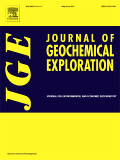
JOURNAL OF GEOCHEMICAL EXPLORATION
Transforming Research into Real-World ApplicationsJOURNAL OF GEOCHEMICAL EXPLORATION, published by Elsevier, is a leading journal in the fields of Geochemistry and Economic Geology, with a notable Impact Factor and a commendable performance demonstrated by its Scopus ranking, where it holds the 22nd position out of 154 in Geochemistry and Petrology and 11th out of 43 in Economic Geology. Founded in 1972 and set to converged through 2024, the journal serves as a vital platform for disseminating high-quality research, providing insights into the complex relationships between geological processes and geochemical phenomena. Its articles contribute significantly to the understanding of natural resource exploration and environmental geochemistry, making it an essential resource for researchers, industry professionals, and students alike. Although not an open-access journal, it offers a wealth of knowledge aimed at advancing the field's boundaries and fostering innovative research initiatives. As an established outlet for the latest findings and methodologies, the journal's contributions ensure it remains at the forefront of geochemical exploration.
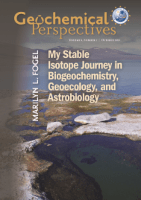
Geochemical Perspectives
Navigating the Frontiers of Earth Sciences.Geochemical Perspectives, published by the European Association of Geochemistry, is a pivotal journal that caters to the dynamic field of geochemistry and its related disciplines. With an ISSN of 2223-7755 and an E-ISSN of 2224-2759, this journal serves as a vital platform for disseminating cutting-edge research and developments from 2012 to the present, and into 2024. Notably, the journal has established itself with impressive rankings, including Q2 in both Geochemistry and Petrology and Geology, and a Q3 standing in Environmental Chemistry for 2023, highlighting its significant contribution to these critical scientific areas. The journal's accessibility, although not open access, ensures that valuable insights and findings are shared within the academic community. Researchers, professionals, and students eager to explore innovative perspectives and applications in geochemistry will find this journal an essential resource in their pursuit of knowledge and advancement in the field.
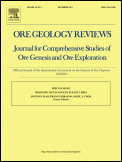
ORE GEOLOGY REVIEWS
Pioneering Research in Geochemistry and PetrologyORE GEOLOGY REVIEWS is a premier academic journal published by Elsevier, renowned for its influential contributions to the fields of Economic Geology, Geochemistry, and Petrology, and Geology. With its esteemed Q1 ranking across these disciplines in 2023, it occupies a leading position in shaping scholarly discussions and advancements within the geological sciences. With an impressive Scopus ranking—47th in Earth and Planetary Sciences for Geology, and among the top 40 in Geochemistry and Petrology—this journal serves as an essential resource for researchers, professionals, and students committed to advancing knowledge in ore geology. Having transitioned to an Open Access model in 2022, ORE GEOLOGY REVIEWS enhances the accessibility of high-quality research, promoting wider dissemination and engagement with cutting-edge findings from 1986 to 2024. As a valued publication addressing the intricacies of ore deposits and geochemical processes, it aims to foster interdisciplinary collaboration and innovation in the field.

MINERALOGY AND PETROLOGY
Enriching the Understanding of Earth's Natural ResourcesMINERALOGY AND PETROLOGY, published by Springer Wien, is a premier academic journal that has been contributing to the fields of geochemistry, petrology, and geophysics since its inception in 1987. With an ISSN of 0930-0708 and an E-ISSN of 1438-1168, this journal is recognized for its rigorous peer-reviewed articles that advance the understanding of mineral and rock formation processes, their physical and chemical properties, and the implications for broader Earth sciences. Holding a respectable impact factor and categorized in the Q2 quartile for both Geochemistry and Petrology, as well as Geophysics, MINERALOGY AND PETROLOGY ranks favorably among its peers, placing it within the top 50% of scholarly publications in these fields. Researchers, professionals, and students alike will find a wealth of knowledge in its pages, as it serves as a valuable resource for those aiming to explore the complexities of Earth's materials and compositions. Although it does not offer an Open Access option, the journal assures high-quality, impactful research that is crucial for ongoing advancements in Earth sciences.

Mineralogical Journal-Ukraine
Advancing the frontiers of mineralogy and geochemistry.Mineralogical Journal-Ukraine is a key academic publication dedicated to advancing the field of mineralogy and geochemistry, under the esteemed auspices of the M.P. Semenenko Institute of Geochemistry, Mineralogy & Ore Formation of NAS Ukraine. Since its inception in 2019, this journal has established itself as an essential resource for researchers and professionals engaged in the study of energy, fuel technology, and the earth sciences, despite its present rankings reflecting a developing impact within these specific categories on Scopus. Published in Ukrainian and available in both print and online formats, the journal not only aims to disseminate high-quality research but also encourages inclusive access to vital findings in mineral exploration, petrology, and geochemical processes. With a commitment to excellence and an expanding scope of research, Mineralogical Journal-Ukraine stands as a pivotal platform for innovation and collaboration among scientists striving to understand the complexities of mineral formation and ore deposits.
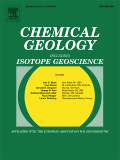
CHEMICAL GEOLOGY
Unveiling the Secrets of Earth Through Innovative ResearchChemical Geology is an esteemed international journal published by Elsevier, dedicated to the rigorous exploration of geochemistry and petrology, with its foundational roots tracing back to 1966. As evidenced by its impressive Q1 ranking in both Geochemistry and Petrology as well as Geology in the 2023 category quartiles, this journal stands as a premier outlet for cutting-edge research and innovative methodologies within these vital fields. With a Scopus rank placing it in the top 10% of Earth and Planetary Sciences, Chemical Geology offers a platform for researchers, professionals, and students alike to disseminate findings that advance our understanding of geological processes and materials. Although it does not currently offer open-access options, the journal remains committed to high-quality publications that contribute significantly to the scholarly community. Located in the vibrant academic milieu of Amsterdam, Netherlands, Chemical Geology is an essential resource for those engaged in the earth sciences, aiming to bridge theoretical insights with practical applications.

AMERICAN MINERALOGIST
Exploring the Depths of Earth SciencesAMERICAN MINERALOGIST, published by the Mineralogical Society of America, stands as a premier journal in the fields of geochemistry and petrology, as well as geophysics, characterized by its prestigious Q1 ranking in both disciplines in 2023. As a vital resource for researchers, professionals, and students, the journal presents cutting-edge research, comprehensive reviews, and innovative methodologies in mineralogy and allied earth sciences. With converged publication years extending from 1968 to the present, it highlights significant advancements and breakthroughs within the realm of mineralogy. The journal's rigorous peer-review process ensures high-quality content that is both informative and impactful, making it essential reading for anyone engaged in earth sciences. Though it does not offer open access, the journal remains widely accessible through academic libraries, providing users with a wealth of knowledge to advance their understanding of mineralogical sciences.

Boletin de Geologia
Unveiling Colombia's Geological Treasures for the World.Boletin de Geologia is a prominent open-access journal published by UNIV INDUSTRIAL SANTANDER, dedicated to advancing the field of Earth and Planetary Sciences. Since its transition to open access in 2000, this journal has provided a platform for researchers to disseminate their findings and engage with the global scientific community. With an ISSN of 0120-0283 and an E-ISSN of 2145-8553, it is indexed in Scopus and has secured a notable Q3 ranking in the category of miscellaneous Earth and Planetary Sciences as of 2023, reflecting the impact and relevance of its published articles. The journal's geographical scope, rooted in Colombia, allows it to highlight significant geological research pertinent to the region while also contributing to global discussions. Scholars and practitioners interested in innovative research within this field will find Boletin de Geologia an invaluable resource for unlocking knowledge and fostering collaboration in the geological sciences.